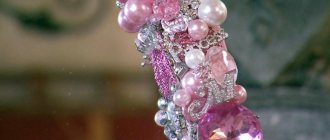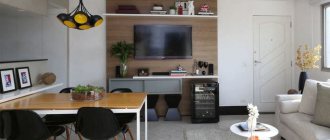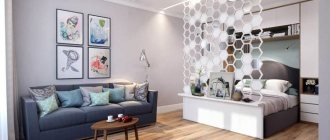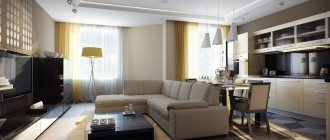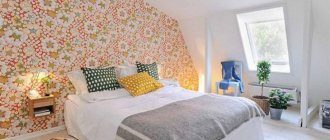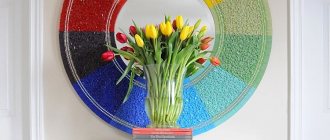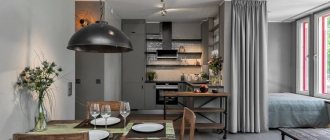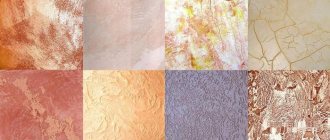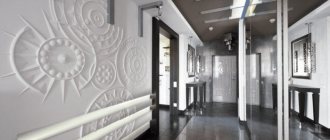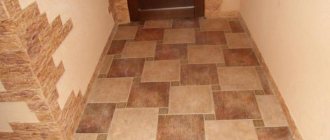When creating a design project, you need to take into account not only the general design of the walls, ceiling, floor, but also an important role should be given to various accessories, paraphernalia, etc. Mirror wall decor is important in the interior. Decorating a wall with mirrors not only looks beautiful, stylish, and elegant, this decorative element visually expands the space, makes a small room appear larger, and creates a 3D illusion.
Mirror wall or a stylish solution to visually expand the space
Decorating apartment walls with mirrors is the latest trend in interior fashion. Designers often use this bright and unusual accent in their projects. After all, this design allows you to easily and naturally expand the space of the room and make it interesting. They are easily mounted on the wall and retain an attractive appearance for many years. However, even the most expensive finishing material can ruin the interior if used incorrectly.
Benefits of placing a mirror in the living room
Existing types of mirrors can improve the appearance of a room. It is important to choose the appropriate model. Also, the layout of the room plays an important role when choosing the location of the mirror. There are so many mirrors! Large and oval, round and rectangular, square and curly. Using each shape, you can create a non-trivial appearance of the living room, place stylistic accents and create the right mood. Using different shapes of mirrors, you can visually enlarge a room or hide repair errors. But in any case, a mirror will make your living room feel freer and more modern.
Proper placement will expand the space, especially in a small living room. Also, you won’t have to clutter the room with unnecessary decorative elements, since the reflection in the mirror will fill the space. The choice of mirror shape will visually change the perception of the proportions of the room, for example, a long mirror will create the illusion of a high ceiling, and a round one will expand the room.
Mirror panels on the wall: when used in the interior
Mirror panels in the interior look beautiful and stylish. They make the apartment design more unusual and attractive. In addition, such a design helps solve some problems in space planning.
Properties of mirror walls:
- Such panels can visually expand the space. By finishing one wall, you get a room that will look more spacious.
- Mirror panels will help correct incorrect layout. By installing such a covering on the desired walls, you will make the room wider or longer.
- A wall decorated with mirrors will decorate the interior. At the same time, it will not look too pretentious or intrusive.
Interior styles
Mirror models in the design of various styles.
Loft
Square, round, rectangular mirrors or canvases of other shapes with different sizes, decorated with wooden, metal frames or laconic iron baguettes, painted in non-trivial colors, will perfectly emphasize the brutality and stylishness of the loft.
The photo shows a narrow floor mirror in a thin black frame in a loft-style bedroom.
Classic
For this luxurious interior, rectangular and triple symmetrical canvases in gilded, silver or bronze baguettes, faceted models or products decorated with stucco would be appropriate. This decor will be the ideal finishing detail of a classic style.
Provence
The overall picture of the French style will be perfectly complemented by vintage reflective surfaces, in patterned frames with the effect of artificial aging and scuffs, products decorated with forged elements and floral paintings, or mirrors with frames that match the natural color scheme of the interior.
Scandinavian
Nordic design embodies beauty, lightness and simplicity, so excessive luxury and provocative accents are not appropriate here. An excellent solution for a cold, but at the same time very cozy Scandi interior would be round, rectangular, square mirrors, tinted canvases or hanging models with a minimalist design.
The photo shows a spacious Scandinavian-style living room with a round mirror located above the sofa.
Modern
In the aristocratic and creative modern style, a large number of reflective models, decorated in ornate frames or curved, wavy, figured and arched mirrors, which will become an integral decor of this slightly asymmetrical design, are especially welcome.
Baroque
Here, large or oval mirrors are often used in massive frames, decorated with stucco, carvings, gilding or complex patterns with mythological or plant motifs.
Modern
Models with the simplest and most uncluttered metal, plastic, wooden frame or chrome elements, in any color range, will favorably emphasize the simple and practical interior elements of the modern trend.
The photo shows a floor mirror with a laconic beige frame in a modern-style bedroom.
Oriental
A mirror is a very important accessory that shapes the style features of oriental design. Rectangular, oval, shaped or arched products in wooden, openwork metal or bone-inlaid frames will significantly change the appearance of the room, add subtle notes to it and will be fully consistent with this direction.
Art Deco
This style involves a peculiar play of images; mirrors with unusual geometry, in brass, copper or gold frames, would be appropriate here. The hallmark of Art Deco is the mirror model in the shape of the sun.
Eco style
Natural motifs and environmental themes of eco-design, which is currently quite popular, will perfectly complement round, rectangular canvases in wooden, bamboo and jute frames or products with an interesting streamlined shape, framed with natural materials.
Minimalism
To add even more aesthetics, practicality and harmony to a minimalist interior, mirrors decorated in simple and laconic ways, such as plastic frames or frameless canvases, will help.
For what rooms in the apartment is it used?
You can decorate almost any room in the house with mirrors. In every room this decoration looks stylish and appropriate. However, it is important to take into account the features of the space when planning the design.
Much depends on the technical characteristics of a particular room. For example, if any material is suitable for decorating a living room, then in the kitchen the finish must be moisture and temperature resistant, and it is also extremely important that the housewife has the opportunity to clean it.
Care Tips
Tiles with a mirror surface are easy to use and care for on a daily basis. It should be wiped regularly with a damp cloth. To avoid streaks, you need to use not just tap water, but special mirror cleaners or table vinegar.
After treating with these compounds, you need to wait a little, and then rinse them off with ordinary running water, and then wipe the surface with a dry rag or cellulose napkin.
In bathrooms, mirror tiles and the joints between them can sometimes be treated with special antifungal compounds. Otherwise, caring for this material is no different from caring for ceramic tiles or mirrors.
If dust and dirt appear on the mirror tiles, they can be easily washed with a regular glass cleaner. The matte surface should be cleaned with plain water and vinegar. For severe stains, cleaning agents for removing limestone are suitable.
Decor with mirrors
It is important to use mirror panels correctly when decorating rooms. There are popular options for decorating walls with this type of finish.
Options for using mirror finishes:
- Covering one wall with a continuous mirror sheet. This decoration will visually expand the room and make it stylish.
- Finish the mirror on the top of one wall. This option is suitable for those who want to make the room stylish, but not overload it with mirror details.
- Decorating the wall with mirror strips or slabs. In this case, you can alternate mirror areas with other materials, such as paint, wallpaper or wood panels. This way of decorating a room will help focus attention on one wall.
- Covering several walls with mirror material. With this design option you need to be careful not to overload the interior. In this way, two adjacent walls are decorated.
- Decorating part of the wall with a mirror cloth. This finishing option allows you to create a stylish accent.
In the corridor and hallway
Corridors and hallways, especially in old houses, are rarely large. Such rooms are cramped, so when decorating them, designers often use various tricks to visually expand them.
The vestibule space is also decorated with mirror panels. However, to do this, consider the shape of the room.
Decorating a hallway with mirrors depending on the shape:
- In a long and narrow corridor, one wall is lined with a mirror. In this case, it is possible to cover both part and its entire height with the material. In order for such a design to give the effect of expansion, it is necessary to take care of high-quality lighting throughout the entire length of the room. It is also desirable that companion materials be selected in light colors.
- A small square hallway needs to be decorated differently. Here they either decorate one of the walls adjacent to the door, or partially decorate two walls adjacent to each other with mirrors.
- Spacious hallways are also decorated with mirrors. However, in this case it is advisable to use partial cladding.
When designing a corridor, you need to take into account that the lower part of the walls is especially susceptible to contamination. Therefore, it is better to decorate only their upper part with such material.
Decorative mirror panels in the bathroom and kitchen
The bathroom and kitchen are rooms with high humidity and constant temperature changes. In addition, the finishing of such premises is especially susceptible to contamination.
Mirror panels are not afraid of high humidity and temperature changes in the range in which this factor is present in the kitchen and bathroom. Unfortunately, dirt on mirror material is very noticeable. Therefore, you need to decide in advance in which area this factor will have less influence on the finishing.
Bathroom and kitchen mirror decoration:
- In the kitchen, it is better not to place a mirror surface where the cooking area is located. This wall will look best above the dining table. In this case, it is advisable to decorate only the upper part with reflective material. In this case, it will be possible to increase the space of the room without reducing its practicality. You can also find interiors with kitchen aprons made of mirror tiles. This design looks very beautiful, but this finish will constantly leave stains and drops of water and grease that will need to be cleaned.
- In the bathroom, the best place to place a mirror is on the top of the wall above the sink. In this case, you can reproduce this design along the entire length.
Types and types of tiles
There are many types of tiles that are used in different interiors. Depending on its type, the installation of this decorative material differs. Smooth tiles without relief are laid in such a way that their joints are invisible. This allows you to make real mirror canvases from it, which look impressive in minimalism and hi-tech styles.
Beveled tiles help create complex surfaces for palace and classical interiors.
Tiles with an imitation metal surface (bronze, silver, gold) are suitable for all styles. Material with a regular or textured pattern (texture) gives the interior individuality and expressiveness. Tinted mirror tiles are distinguished by different shades of glass or amalgam surface: smoky gray, white, pink. Mirror mosaic will fit into Art Deco and Art Nouveau styles.
Mirror tiles are also classified according to their shape; the most common options are: square, triangular, rectangular, hexagonal (honeycomb).
What are the different types of wall mirror panels?
There are different types of materials with a reflective surface. First of all, they differ in materials of manufacture.
Materials for making mirror panels:
Mirror panels also differ in their release form. There are several variations of this finish.
Acrylic mirrors
Advantages of acrylic walls:
- They are characterized by high strength.
- They are temperature resistant and can be used at temperatures up to +70 degrees.
- Do not change appearance when exposed to sunlight.
- Flexible, making them easy to work with.
- They look almost the same as a glass mirror.
Despite its advantages, such products also have disadvantages. The mirror surface is easy to damage.
Tile
The tiles can be made from ordinary impact-resistant glass. This material is characterized by increased durability and special beauty, and has different shapes and sizes. Thanks to this, you can use it to lay out patterns.
However, this finishing option will be quite expensive. In addition, it is quite difficult to work with.
Flexible plastic film
Mirror-coated PVC panels are another option. This material also has many advantages.
Advantages of plastic mirror coating:
- Durable, not afraid of impacts.
- This is a flexible material that is easy to cut into the desired shape.
- Plastic panels are moisture resistant. In addition, they are not afraid of chemicals.
Disadvantages include the fragility of this material and its instability to ultraviolet radiation. Therefore, it is not very expensive.
Stripes
Strips of mirror material can be made of either plastic or acrylic. With this finishing you can create a very interesting design. The mirror goes well with paint, wallpaper, wood, tiles and even decorative stone and brick.
It is not necessary to buy ready-made strips. You can buy a flexible mirror sheet and cut it into strips.
One-piece fabric
You can decorate an entire wall with a single piece of canvas. The required sizes can be ordered from the seller. However, plastic sheets are sold in rolls, which allows you to cut the desired length and width yourself.
A little about mirror stickers, panels and panels
What are they made of? Similar design elements are made from acrylic mirrors or vinyl film. In the case of panels, they are available in the form of a roll or plates; they are especially popular in the bathroom. The panel can be made in the form of tiles, or in a single piece, sufficient to cover a cabinet door in the hallway, bedroom, kitchen, or broken into small pieces - a mosaic. Stickers are small shaped elements in the form of simple images that are glued to the wall in any order. These can be watches, geometric images, animal shapes and entire prefabricated paintings.
Stylish interior of a modern dining room
Wall decoration with mirror panels
Where is the best location? It is better to place decorative elements in places where they receive direct sunlight, then their reflections give a new look to the entire design of the room, the reflection transforms the interior. It is best to glue stickers or film, or place panels on a free wall without additional piles, otherwise the entire effect will be lost. Decorators on many sites provide examples of photos of erroneous and good interiors.
Mirror panels in a classic living room
Many people, when trying to create a design with their own hands, make some common mistakes, which designers have already collected in a collection and published more than one book with photos and tips on how to avoid them.
Mirror tiles in the living room interior
Beautiful interior in fusion style
Tile wall in the interior: how to install it yourself
Mirror tiles are glued using regular tile adhesive. The glue can be applied in a layer of 5 mm to the inside of the tile, carefully leveling it with a special spatula. Next, the elements are applied to the wall in the required order and pressed. Between them it is necessary to place special crosses that will help make an even seam.
After gluing, the tile seam is rubbed with a special compound. After it dries, the wall is washed.
How to glue plastic panels
Plastic panels usually have a self-adhesive backing. This greatly simplifies installation. However, there are also pitfalls here.
The nuances of gluing mirror tiles:
- The wall that will be lined with this material must be perfectly flat. Otherwise, the panels simply won't stick.
- Before gluing, the panels must be laid out on the floor for 3 days.
- Next, the wall is covered with a primer. After this, you can glue the material.
Features of self-installation
Mirror tiles are easy to install yourself, which is probably why they are so popular today. Its installation is practically no different from laying simple tiles. But you need to take special adhesives, since ordinary cement-based adhesive spoils the reflective layer of the tile - the mirror amalgam.
Laying begins with preparing the walls: the remnants of the wallpaper are torn off, the walls are plastered, all protrusions are removed, and then the surface is treated with a primer. In bathrooms and bathrooms, the walls are also treated with special substances against mold and mildew.
After the primer has dried, you need to draw markings directly on the wall and begin work on laying the decorative material. In bathrooms and kitchens, a small (1-2 mm) thermal joint should be left between the tiles. Traditionally, this material is attached from the bottom up, after which all seams are rubbed down and the lining is cleaned of traces of glue.
Useful video on installing mirror tile panels:
Recommendations for selection and placement according to Feng Shui
Tips for selection and placement:
- According to Feng Shui, it is not desirable to place mirrors opposite the sleeping and working places. Also, you should not place or hang products in front of a window or door, as this may contribute to incorrect reflection of the energy flow.
- In the kitchen or dining room, it would be correct to place a reflective surface opposite the dining table.
- It is believed that in an apartment or house there should be at least one large mirror model with a full-length reflection.
Drawings and engravings on the surface
With the help of beautiful lines and multivariate patterns, it is possible to decorate the canvas in a truly original way.
A mirror wall in the interior is both an original design solution and a way to increase space in the apartment
Designers of all times have vied with one another to claim that a mirror wall is a way to visually enlarge a small space. Indeed, this innocent “deception” served only this purpose for many decades - people simply placed a cast reflective sheet on a piece of the wall of the living room, hallway or bathroom. Today, technology allows apartment and house owners to create their own designs and realize their wildest fantasies.
Source
Types of mirrors
There are several types of mirror products.
Floor
These models are not only an excellent decoration element that attracts all attention, but also provide an excellent full-length reflection. Floor mirror structures with legs are considered the most practical and popular, as they are the most comfortable and stable.
The photo shows a floor mirror in a wide black frame in the bedroom.
Mounted
Fashionable, stylish, popular and with many undeniable advantages, wall-mounted models competently level out planning flaws and minor wall defects. Such mirrors occupy a minimum of usable space, which allows them to be used even in small rooms.
Built-in
Types of built-in mirrors:
- In furniture. Properly placed furniture with a built-in reflective surface will reflect artificial or natural light flux, thereby giving the room additional light and a certain visual lightness.
- Into the wall. This option is particularly logical and ergonomic.
The photo shows a small children's room with mirrors built into the wardrobe.
Glass processing methods
The construction of a solid wall of mirror panels is a rather bold decision, so designers use products that have special processing aimed at highlighting each mirror element and smoothing out the reflective effect. The same principle is used when creating decorative mirror panels.
Beveled tiles
This is the most popular method of processing the material, which gives the wall a more complex relief. A bevel is a beveled edge of a mirror panel.
Due to the facets, each element acquires additional volume and becomes, as it were, convex, while the edges also have a reflective effect and create a play of light flows that are refracted in them.
In a bright bedroom in a minimalist style, a beveled wall can be used at the head of the bed. At the same time, psychological discomfort will be reduced, and thanks to the facet cutting of the tiles, the effect of fragmenting the space will be eliminated. Since nothing will interfere with the reflection of lighting fixtures, the room will be bright and light.
Note! The layout of beveled tiles can be represented by rhombuses or rectangles of the same or different shapes.
The larger the beveled edge, the less reflective the mirror tile becomes. As a result, the effect of duplicating space is practically eliminated, but the visual expansion of space is preserved.
Emphasis on joints
In this case, gaps are left between the mirror elements or additional edging and framing are used to imitate them. To create a similar effect, it is possible to use wooden slats and beads, plasterboard moldings, wooden, plastic or metal frames. At the same time, using a frame, you can decorate each mirror tile in the form of a picture.
Kingdom of Crooked Mirrors
To create the effect of distracted attention, mirrors with a fuzzy or curved reflection are used. They are obtained using special heat treatment. As with the facet, the effect of expanding space is fully preserved.
Mirror placement options
The most popular accommodation options are:
- Ceiling. A mirrored ceiling surface allows you to completely change the geometry of the room, deprive it of spatial boundaries, bring in light and air and create a special mysterious atmosphere.
- Wall. Wall placement will give the room the missing depth, adjust its proportions and significantly save space.
- Doors. A door leaf with a mirror is considered a fairly successful design solution, allowing you to set the ceremonial mood of the room.
- Furniture. Various pieces of furniture with built-in mirrors are perfect for those who want to decorate the interior with a large mirror model and at the same time save useful space in a small room.
The appearance of the entire space and the interior as a whole will depend on the correct location.
Mirror above the sofa in the living room
Installing a mirror above the sofa in the living room should only be entrusted to professionals. Saving on specialist services does not guarantee quality and may become unsafe. For example, if a mirror needs to be attached with glue, then professionals will use only special materials that will not allow dark spots to appear on the mirror surface in the future.
If you place a mirror above a sofa, chest of drawers, fireplace or other surfaces, then make sure that no more than a couple of large interior items are reflected.
A mirror above furniture only works in combination with light. Without the necessary lighting, the mirror will not fulfill its decorative purpose, so be sure to provide lighting or decorate the mirror with a table lamp.
The placement of a large mirror surface opposite the sofa in the living room creates an uncomfortable psychological atmosphere. Neither guests nor hosts should constantly see their reflection. Above the sofa is the best place for a mirror!
Design and decor of mirrors in apartment decoration
Original ideas for the design and decoration of mirror products.
Without frame
Despite the fact that without a frame the canvases look too simple and empty, they do not create discomfort in the room, but rather fill it with notes of novelty and a certain futurism.
Aged
These antique reflective surfaces, due to their special luxury and visibility, individualize the interior and impart mystery to the atmosphere.
Faceted
Faceted fragments, thanks to the faceted surface, will fill the room with a scattering of diamond reflections.
Backlit
Due to different lighting, the product takes on a lighter and weightless appearance and becomes an elegant and very beautiful accent detail of the entire room.
The photo shows a large luminous full-length mirror in a modern hallway.
Panel of mirrors
The mirror panel is particularly atmospheric and unusual. Such truly chic decor can transform and decorate even the simplest interior design.
The photo shows a living room with a white brick wall decorated with a decorative panel of mirrors.
In the shape of the sun
It is a real art object that has not only functional qualities, but also allows you to fill the environment with completely new colors.
With patina
Due to the softening of the cold mirror gloss, canvases with patina have completely different reflective abilities, which adds mystery and historicity to the atmosphere.
Composition of mirrors
Such an ensemble undoubtedly becomes a very stylish element of decor and a compositional center that attracts all eyes.
The photo shows a composition of mirrors on the wall in a Scandinavian style dining room.
Venetian
An elaborate frame, most often with a pattern, made from a mirror, is a characteristic feature of the Venetian canvas. This decor gives the environment additional effectiveness, volume and an unusual play of light.
Features of mirror surfaces
A mirror wall correctly placed in the interior:
It is important to remember that mirrors have some nuances when used:
Important! The mirror multiplies everything twice, so you need to carefully choose the location of such a surface.
Where is it recommended to use
You can decorate any room with mirrored walls. Often this finish acts as an alternative to a regular mirror, and is used in the interior of a bedroom, hallway or bathroom.
You can find such panels on the walls in the following premises:
When decorating other rooms - living room, dining room, kitchen, mirror panels on the walls play a decorative role. They allow you to adjust the geometric parameters of the room, make it narrower or wider, and add light and lightness.
Design techniques
To create solid mirror walls, large mirror slabs are used, made to order, taking into account the individual characteristics of the room. Their price is quite high. At the same time, it is important to make the joints as inconspicuous as possible in order to get the effect of the whole canvas.
Designers offer several techniques that are used when constructing solid mirror walls. It won’t be difficult to repeat them with your own hands.
The main one is the effect of the absence of a wall, in which the boundary of the wall is not determined, but only the reflection is visible. This result can be achieved by close contact of the panels forming a monolithic mirror coating.
The instructions are simple. If you place such a wall opposite the front door, then when looking from the corridor there will be a feeling of its absence. At the same time, the small hallway will become visually wider. In this case, it is important to use light-colored ceiling and floor finishes, and to provide high-quality lighting not only indoors, but also outside (at the entrance).
Note! There is a statement that it is not recommended to place large furniture against the background of a mirrored wall. As practice shows, this is not always the case, as is the recommendation to abandon mirrored walls in rooms with a lot of decor. The main condition is that massive furniture should be light or white, and decorative elements should form a single composition.
Another technique is to use a decorative coating instead of a regular mirror. When installing solid walls, mirror panels are tinted.
Many mirror workshops offer tinting services for products in any shade, which allows such panels to fit into the existing interior in the most harmonious way.
For example, you can use mirrored tinted slabs to create a zoning partition, which will create an unusual, magical visual effect of an otherworldly space in the room. In this case, the boundaries of the structure will be clearly marked.
Modern mirrors in the living room: creating a stylish space
In an aristocratic modern room design, it is advisable to insert mirrors into the bowserie. This way you can play up the interior with color and create an impressive spatial effect. To visualize the living room interior, you can place horizontal or vertical stripes of mirrors. For example, thin stripes in the form of a sofa edging create the effect of floating furniture, and mesmerizing longitudinal lines up to the ceiling increase the height of the room.
Panoramic placement of floor-to-ceiling mirrors will not only help to visually increase the space, but will also add some charm to the interior.
Basic rules for placing a mirror in the living room
- You cannot place mirrors opposite each other. This interferes with orientation and does not in any way affect the visual expansion of the living room.
- If you need a mirror without a frame, then pay close attention to the processing of the edge.
- Mirrored ceilings in the living room are inappropriate. This solution is more suitable for a bedroom, bathroom or low rooms.
- A gallery of mirrors will break up the living room wall and reduce the height of the room. The effect of making a room larger or smaller also depends on the frame of the mirror.
- Mirrors leaning against the wall look interesting, especially near furniture. Moreover, if the mirror has a massive frame, then floor installation will prevent the risk of the mirror falling from the wall due to the load.
- A mirror opposite the window makes the room brighter.
- Reflections of beautiful objects, colorful flowers, and photographs of happy moments in mirrors create a positive mood.
